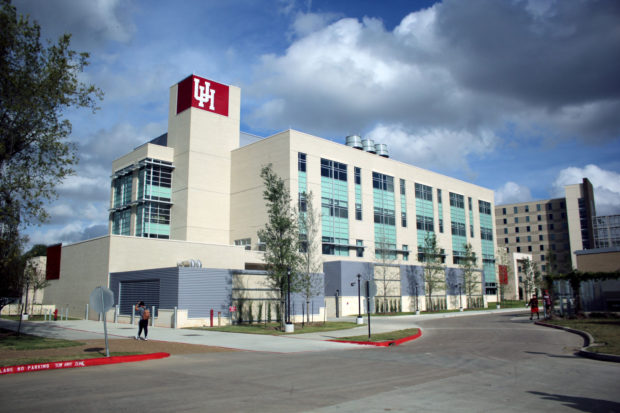

The building is between the Michael J. Cemo Hall and the Cullen College of Engineering will house a number of new inter-department research collaborations. | Thom Dwyer/The Cougar
Correction: A previous version of this story had incorrectly refered to CACDS as “Cactus”. This version of the story has been updated to reflect the change.
With the opening of the new Multidisciplinary Research and Engineering Building (MREB), UH hopes to continue cementing its status as “Tier One” and one of Texas’ top research institutions.
The four-story, 120,000 gross square-foot MREB contains labs, office space, conference rooms and a cutting-edge, high-performance computing center for the Center for Advnced Computing & Data Systems, also known as CACDS. In early November, certain departments received the go-ahead to move into the building.
“The building is a collaboration between engineering and the Division of Research,” said Hanadi Rifai, the Cullen College of Engineering’s associate dean for research and facilities. “CACDS will be in the building, and there will be faculty who are engaged in computational research where they use high-performance computing.”
The project, located between Michael J. Cemo Hall and the Cullen College of Engineering complex, totaled $51 million. The engineering college provided $5 million and alumni donations funded another $10 million. The Division of Research and other University sources provided the remaining amount.
Besides the new facilities, the MREB differs from other similar buildings on campus in how it encourages collaboration between disciplines.
According to the campus’ Facilities Planning and Construction, the building will limit “investments in multiple, redundant facilities by holding the core functions in a neutral location.”
“The opportunity to be able to work together and interact and write proposals together and do research together is what I think elevates and allows the faculty more opportunities,” Rifai said.
Another unique feature of the building is the “plug-and-play” labs that feature movable tables and shelves. This allows researchers to design a space that fits their project needs.
Among other projects, the MREB will host a cooperation between the department of chemistry and the department of chemical and biomolecular engineering.
“Many of the faculty involved in the Welch Polymer Center will have the ability to collaborate together and be involved in the facilities at MREB, allowing them to write grants together and be able to elevate the research they are doing in that area,” Rifai said.
According to the Cullen College of Engineering, the new facility will raise annual research expenditures to $36 million and bring approximately $612 million worth of economic activity into the city.
The increased research funding is expected to lead UH to hire more faculty and add more than 250 new graduates. It will also elevate the Cullen College of Engineering into one of the top programs in the nation.
A report from The American Bazaar, a publication on Indian-Americans, said that the two families who donated to MREB’s construction will have floors named after them.
The ground floor, known as Mehta Family Engineering Research Center, is named after the Mehta family, who had four siblings all graduate from the Cullen College of Engineering.
The second floor will be the Druga and Sushila Agrawal Floor, whose name is based off Board of Regents member Durga Agrawal and his wife. Agrawal earned his doctorate in industrial engineering at UH.
SHW Group, a subsidiary of architecture and engineering firm Stantec, designed the building. On its website, it said that the MREB will feature advanced labs, a training facility and a server room. The facility will also feature shell space for future growth, with construction continuing into 2017.
The MREB’s collaborative-between-disciplines aspect is a first for UH and rivals that of facilities on other Texas campuses.
“We know of many other similar buildings where the focus is on collaborative and multidisciplinary research,” Rifai said. “It’s certainly very competitive with many of the other similar research facilities at other campuses.”
news@thedailycougar.com
—
“New building to host cross-discipline engineering, health research” was originally posted on The Daily Cougar
